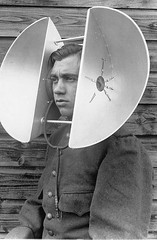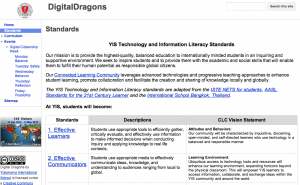One of the requests I hear from teachers regularly is that they would like specific outcomes for student learning with technology – basically what students need to know at each grade level. Often they are keen to use technology in their classrooms, but they’re just not sure what the expectations should be, and what they should focus on in their classroom.
 I have to admit that in the past, I’ve shied away from these kinds of lists because I was so worried that they would be out of date as soon as they were created. (Anyone remember the old ISTE NETS standards before the refresh?) I also worry that these documents are usually so focused on the tools (that change so quickly) that we forget the skills, attitudes and behaviors that will stay relevant, no matter how the tools change.
I have to admit that in the past, I’ve shied away from these kinds of lists because I was so worried that they would be out of date as soon as they were created. (Anyone remember the old ISTE NETS standards before the refresh?) I also worry that these documents are usually so focused on the tools (that change so quickly) that we forget the skills, attitudes and behaviors that will stay relevant, no matter how the tools change.
So, when this conversation came up at YIS last year, I realized that we really did need something. A document that can help guide teachers toward a common vision, can clarify expectations, and can share concrete examples of what this kind of learning looks like in action.
Around this time last year, we created a working group of teachers to develop our own standards document. Teachers from each division, as well as each subject area participated to ensure that the final document would represent as many different perspectives as possible.
Thankfully, we were able to build on the previous work of our fantastic technology, library and coaching team at ISB, by using aspects of the standards we created while I was there as a starting point (thanks ISB21 Team!). At ISB we started with our essential understandings for 21st century literacy, built guiding questions, then applied the internationally recognized standards, and selected appropriate benchmarks from the State of Victoria, Australia. Although it wasn’t an intentional goal, we really did end up with a very international document!
Since we had such a fantastic foundation to work from, we were able to review, reflect and refine the document to meet our specific needs at YIS. As a team, we wanted to ensure that this document:
- Provides a clear vision and framework for learning with technology
- Combined technology and library standards into one streamlined document
- Represented internationally recognized standards (like ISTE and AASL)
- Does not focus on specific tools, but rather the skills that will be developed
- Reflects the PYP, MYP and DP approach and perspective (at each divisional level)
- Emphasizes our Connected Learning Community vision
- Includes practical examples of each benchmark
Our mission is to provide the highest-quality, balanced education to internationally minded students in an inquiring and supportive environment. We seek to inspire students and to provide them with the academic and social skills that will enable them to fulfill their human potential as responsible global citizens.
Our Connected Learning Community leverages advanced technologies and progressive teaching approaches to enhance student learning, promote collaboration and facilitate the creation and sharing of knowledge locally and globally.
The YIS Technology and Information Literacy standards are adapted from the ISTE NETS for students, AASL Standards for the 21st Century Learner and the International School Bangkok, Thailand.
At YIS, students will become:
Standard 1: Effective Learners: Students use appropriate tools to efficiently gather, critically evaluate, and effectively use information to make informed decisions when conducting inquiry and applying knowledge to real life contexts.
CLC Vision Statement: Attitudes and Behaviors: Our community will be characterized by inquisitive, discerning, open-minded, and self-directed learners who use technology in a balanced and responsible manner.
Standard 2: Effective Communicators: Students use appropriate media to effectively communicate ideas, knowledge, and understanding to audiences ranging from local to global.
CLC Vision Statement: Learning Environment: Ubiquitous access to technology tools and resources will enhance our learning environment, expanding horizons beyond the physical classroom. This will empower YIS learners to access information, collaborate, and exchange ideas within the YIS community and around the world.
Standard 3: Effective Creators: Students demonstrate creative and critical thinking, construct knowledge, and develop innovative products and processes using appropriate technology.
CLC Vision Statement: Educational Experiences: Educational experiences will be authentic, imaginative, and provide for different learning paces and styles. Learners will be encouraged to become independent and enterprising in order to meet the challenges of a constantly changing world.
Standard 4: Effective Collaborators: Students connect with peers and recognized experts to collaborate, develop their own understanding, contribute to the learning of others, and contribute to the global society using a variety of media and online communities.
CLC Vision Statement: Community: Our Connected Learning Community will provide a sense of identity and belonging that will enrich our overall school community and connect us with others around the globe.
Standard 5: Ethical Citizens: Students practice legal and ethical behavior with an understanding of cultural and societal issues related to technology and information.
CLC Vision Statement: Actions and Decisions: Our actions and decisions will demonstrate responsible digital citizenship, reflect our school values and create a positive online presence.
Within each standard we included essential questions, statements describing each aspect of each standard, and benchmarks for K-2, 3-5, 6-8, 9-12.
 At two separate meetings (one in the ES, facilitated by Elif, our ES ICT Facilitator and Shanel, our ES VP and a another meeting in the MS/HS facilitated by me and Susie, our MS VP), we asked teachers to review the documents for understanding, accessibility, and relevancy. The majority of the feedback we received was based on the formatting of the documents and the need for a number system to easily identify each benchmark.
At two separate meetings (one in the ES, facilitated by Elif, our ES ICT Facilitator and Shanel, our ES VP and a another meeting in the MS/HS facilitated by me and Susie, our MS VP), we asked teachers to review the documents for understanding, accessibility, and relevancy. The majority of the feedback we received was based on the formatting of the documents and the need for a number system to easily identify each benchmark.
Over the past few weeks I’ve been working on making our standards easily accessible, well-organized, and easy to identify (and therefore track within our curriculum documentation). In order to continue to highlight the importance of these benchmarks, I thought they would work well on our Digital Dragons site (home to our Digital Citizenship Curriculum and Events). I was able to use a table of contents in the overall Google Doc to link each standard to it’s benchmarks – hopefully this will make it easier for teachers to find what they’re looking for.
Here’s what our standards look like now. We’ll be building on these as we create other scope and sequence documents, like this one for blogging, which we also started last year.
What do you think? Are they easy to navigate? Have we identified the most important aspects of learning with technology and information literacy? Are we missing anything important?
We’ll be going over these again at the beginning of next year to again highlight the expectations we have for students, so any advice or suggestions are greatly appreciated!
Image Credits:
- giant rulers by massdistraction, CC licensed on Flickr
- dual-head-mounted-listening-device by x-ray delta one, CC Licensed on Flickr






hi, just found your blog (will have to spend some time going through your older posts) which looks great. I’m a Primary teacher in Australia and am currently working on my Masters in Learning and Development in Digital Pedgogy and Online Learning. I’d love to keep in touch if possible and have fb’d you if possible. My aim is to encourage Prep-Year 3 students in Australia to work with ICT on a daily basis, integrating it into their lessons where possible. Early primary ICT research seems to be rather limited at the moment but the Australian government are trying to catch up with the rest of the world re ICT integration but from a top-down approach. We have a slight chicken-egg problem where limited research within Australia on primary ICT use means limited funds, which in turn mean limited research (knowledge) about ICT in early primary. Anyway, hope we can stay in touch and share ideas, nice to meet you. Steph
Stephanie Flynn´s last blog post ..48 iPad Apps That Teachers Love
These standards are so helpful in the battle of deciding how to use technology to keep students competitive but most importantly learning and not distracted with materials which are not aligned!